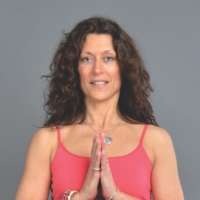
Yoga often happens in millimeters, which means that relatively small adjustments can produce some of the most important openings and energetic shifts.
Karen Britton
Going Slow has Great Benefits
Yoga often happens in millimeters, which means that relatively small adjustments can produce some of the most important openings and energetic shifts. Going slow allows an opportunity to be fully present and to feel the importance of how postures touch the body. This allows you to make important decisions on how far you can take the pose and, perhaps, adjust your body, and modify to your individual needs. Going slow allows you to feel the nuances of a yoga posture. There’re very light and very effective. These small adjustments can have big effects on the body, internally and externally, and to the mind.
You do not have to be flexible to do yoga. Yoga will make you flexible. Yoga is an individual practice, and we each move to our own degree.
Let’s explore Revolve Triangle Pose. The benefits: it will help the spine and muscles of the back to function properly, as the pose increases blood supply around the lower part of the spinal region. The chest is fully expanded. This pose strengthens thigh, calf and hamstrings muscles and relieves back pain. It invigorates abdominal organs, which improves digestion and detoxes body. It strengthens hip muscles, tones and strengthens abdominal muscles and improves balance and concentration.
Before trying the posture, read the instructions below and watch the accompanying video.
It’s important to remember that what you do with your feet can determine what happens in your pelvis and back. Therefore, it’s important to “set” the feet.
- Stand at the front of your mat and step your right foot back about two or two and a half feet. (This is an approximate distance.) Line your heels up. This next cue is very important as explained in the video. Your rear foot should be turned in at 45 degrees so that the big toe faces the front right corner of your mat. This position of the rear foot turned in will allow your pelvis to turn forward comfortably without causing discomfort to lower back and knee. Your pelvis should now be square to the front, allowing freer movement of the spine, and your right knee is protected.
- Here’s one of those nuances we can feel while taking it slow and mindful. Press into the outer edge of your right foot and the big toe of the right foot. This balances the weight of the foot, and, just as importantly, will slightly lift the sole of the foot. This subtle emphasis helps strengthen the arch ligament and may help prevent flat feet.
- Inhale your right arm up and exhale your hand to your thigh or calf, never on the knee joint. These are your first modifications. If you cannot twist, remain here in a half forward bend. Should you have more range of motion, take your hand to the mat next to your foot. The fullest expression is to take your hand outside of the foot. Keep hand next to the foot. A block may also be used to place your hand on.
- If you can move into the twist, inhale left arm up turning the palm out or modify the hand to the low back and rotate open from your shoulder.
- Should your neck bother you, look down to your left foot. Otherwise look at your left hand. Hold for five breaths.
- Release by exhaling and looking down, press into the feet, inhale to come up and step your right foot forward to meet the left.
- Repeat on the other side being mindful that you’re not holding the breath at any time.
Namaste
Watch the Video:
Sponsored Links
[video_embed name=”Revolve Triangle Pose”]
About the Author

Karen Britton
Karen Britton is a certified Yoga Instructor and a regular contributor to Fit to Print. She teaches Yoga classes and programs at Fitness Incentive.


